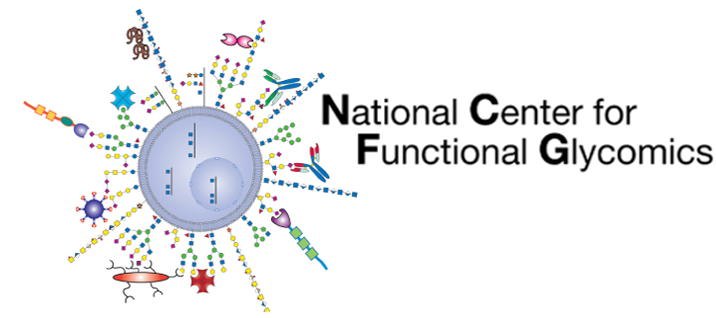1.Introduction:
1.1.Primary objective is to determine the binding specificity of Polyclonal Antibodies or Serum submitted by investigators, using the printed glycan microarray.
2.Reference:
2.1. www.functionalglycomics.org
3.Materials needed:
3.1.Glycan printed slides, printed on the side of the slide with the white etched bar code and black marks- DO NOT TOUCH THIS AREA
3.2.Cover slips (Fisher scientific, 12-545F)
3.3.Humidified Slide processing chambers (Fisher scientific, NC9091416), or homemade system using Petri Dish, with wet paper towels in the bottom of the chamber
3.4.100 ml Coplin jars (3) for washing slides
3.5.Tris-HCl (Fisher scientific, BP152-1)
3.6.NaCl (Fisher scientific, S271-3)
3.7.CaCl2 (Fisher scientific, C79-500)
3.8.MgCl2 (Fisher scientific, BP214-500)
3.9.dH20
3.10.Fluorescently labeled secondary antibody to polyclonal antibody or serum (correct species, type, isotype)
3.11.Bovine Serum Albumin (BSA), Protease Free, LY-0081 (Boval Company)
3.12.Tween-20 (EMD Biosciences, 655205)
3.13.GenePix 4300A scanner (Molecular Devices)
4.Buffers:
4.1.TSM= 20mM Tris-HCl, pH 7.4 150mM NaCl, 2mM CaCl2, 2mM MgCl2
4.2.TSM Wash Buffer (TSMW)= TSM Buffer + 0.05% Tween-20
4.3.TSM Binding Buffer (TSMBB)= TSM buffer +0.05% Tween 20 + 1% BSA
Comment: For buffer preparation see Direct Glycan Binding Assay for Fluorescent Labeled Sample: 4. Buffers
5. Protocol:
5.1.Make working stocks of washing buffers (TSM, TSM Wash Buffer, and H2O) or collect reagents and bring to room temperature if they have been in the refrigerator.
5.1.1.Buffer (A) TSM- 20mM Tris-HCl, pH 7.4 150mM NaCl, 2mM CaCl2, 2mM MgCl2
5.1.2.Buffer (B) TSM Wash Buffer (TSMW) - TSM Buffer + 0.05% Tween-20
5.1.3.Buffer (C) TSM Binding Buffer (TSMBB) – TSM buffer +0.05% Tween 20 + 1% BSA
5.1.4.dH2O
5.2.Prepare 100 µl of sample by diluting antibody or serum in TSMBB or appropriate Binding Buffer based on properties of antibody or serum to a final concentration of 1-50 µg/ml or an appropriate concentration or dilution required for the analysis- several dilutions may need to be tested if concentration is unknown or for serum.
5.3.Remove slide(s) from dissector and label slide with sample name near barcode, outside of the black marks.
5.4.Hydrate the slide by placing in a containing 100 ml of TSMW for 5 min.
5.5.Remove excess liquid from slide by setting the slide upright on a paper towel to drain the liquid off, and wipe the back of the slide with a Kim wipe.
5.6.Carefully apply 70 µl of sample (see 5.2) close to the left edge slide in between the black marks.
5.7.Slowly lower cover slip onto the slide, trying to avoid the formation of bubbles in the sample under the cover slip; carefully remove any bubbles trapped between the slide and cover slip by gently tapping with a pipette tip, making sure the cover slip is between the black marks.
5.8.Incubate slide in a humidified tray in the dark for 1 hr at RT.
5.9.After 1 hr incubation, remove cover slip by gently allowing it to slip off into the glass trash/biohazard waste and pipette a small amount of TSMW over the slide surface to remove the sample.
5.10.Wash the slide by gently dipping 4 times into 100 ml of TSMW in a Coplin Jar.
5.11.Remove excess water from slide by tipping the slide upright.
5.12.Add 70 µl of AlexaFluor-488-labeled (or other label) secondary antibody.
5.13.Cover slip as above (5.7) and incubate as above (5.8)
5.14.After 1 hr incubation, remove cover slip by gently allowing it to slip off into the glass trash/biohazard trash and pipette a small amount of TSMW over the slide surface to remove the sample.
5.15.Wash the slide by gently dipping 4 times into 100 ml of each of the following buffers in Coplin Jars:
5.15.1.TSMW
5.15.2.TSM
5.15.3.dH2O
5.16.Spin slide in slide centrifuge for ~ 15 seconds or remove water under a gentle stream of nitrogen, and wipe the bottom of the slide to remove any droplets of water.
5.17.Scan in a fluorescent Scanner at the appropriate wavelength(s) (See Scanning Protocol).
NOTE: Record procedures on Glycan Array Processing Form (GAPF).
Record Slide number on GAPF and fill out worksheet log form regarding sample information and slide number.
***Some samples may require different buffers or conditions.***
